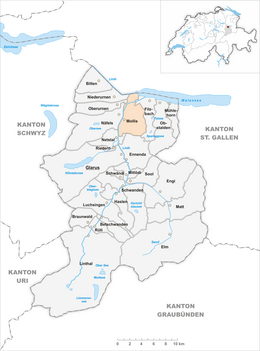Mollis
| Mollis | ||
|---|---|---|
| Former municipality of Switzerland | ||
 |
||
|
||
| Coordinates: 47°06′N 9°05′E / 47.100°N 9.083°ECoordinates: 47°06′N 9°05′E / 47.100°N 9.083°E | ||
| Country | Switzerland | |
| Canton | Glarus | |
| District | n.a. | |
| Area | ||
| • Total | 21.83 km2 (8.43 sq mi) | |
| Elevation | 433 m (1,421 ft) | |
| Population (December 2015) | ||
| • Total | 3,337 | |
| • Density | 150/km2 (400/sq mi) | |
| Postal code | 8753 | |
| SFOS number | 1617 | |
| Surrounded by | Ennenda, Filzbach, Näfels, Netstal, Niederurnen, Oberurnen, Weesen (SG) | |
| Website |
www SFSO statistics |
|
Mollis is a former municipality in the canton of Glarus in Switzerland. Effective from 1 January 2011, Mollis is part of the municipality of Glarus Nord.
Mollis is first mentioned in 1288.
Mollis has an area, as of 2006[update], of 21.8 km2 (8.4 sq mi). Of this area, 41% is used for agricultural purposes, while 44.9% is forested. Of the rest of the land, 8.2% is settled (buildings or roads) and the remainder (5.9%) is non-productive (rivers, glaciers or mountains).
The municipality is located on the right side of the Linth valley. It includes the area from the Linth Canal and Walensee to the Schlattbach in the Netstal. It consists of the village of Mollis and the hamlets of Beglingen on the Kerenzerberg and the alpine settlement of Mullern.
Mollis had a population (as of 2010) of 3,337. As of 2007[update], 12.1% of the population was made up of foreign nationals. Over the last 10 years the population has grown at a rate of 4.6%. Most of the population (as of 2000[update]) speaks German (90.8%), with Italian being second most common ( 2.8%) and Albanian being third ( 1.9%).
In the 2007 federal election the most popular party was the SPS which received 54.1% of the vote. Most of the rest of the votes went to the SVP with 34.1% of the vote.
In Mollis about 73.4% of the population (between age 25-64) have completed either non-mandatory upper secondary education or additional higher education (either University or a Fachhochschule).
...
Wikipedia




